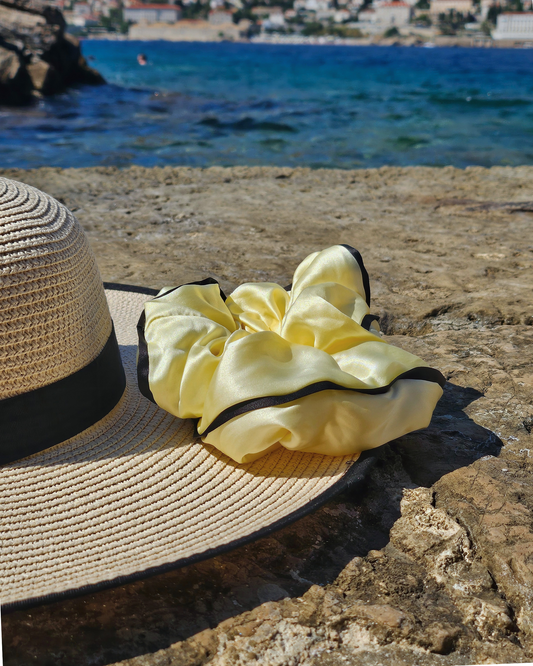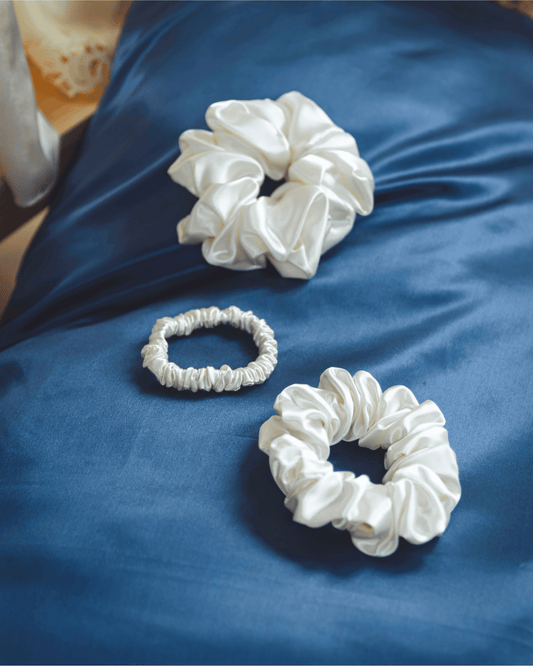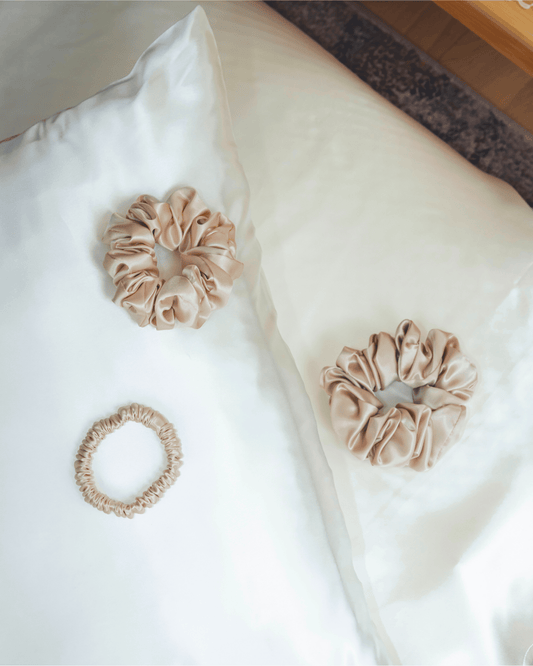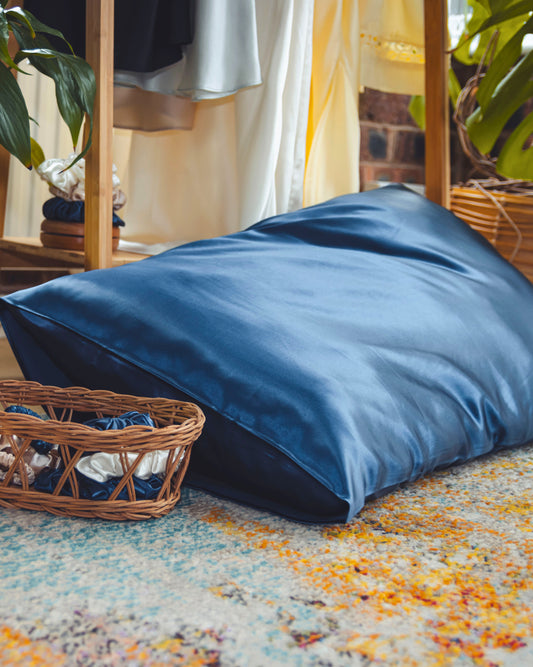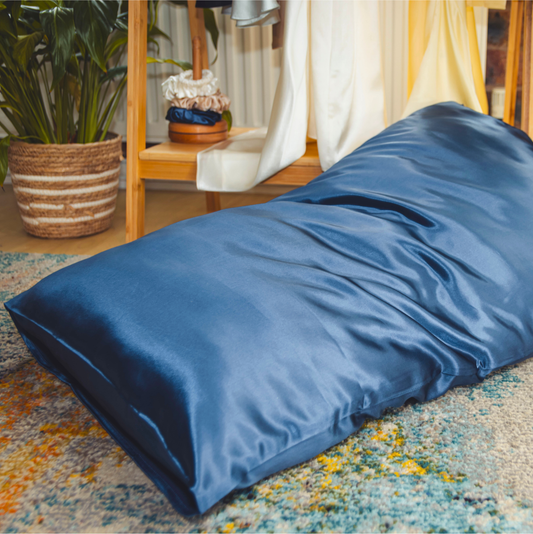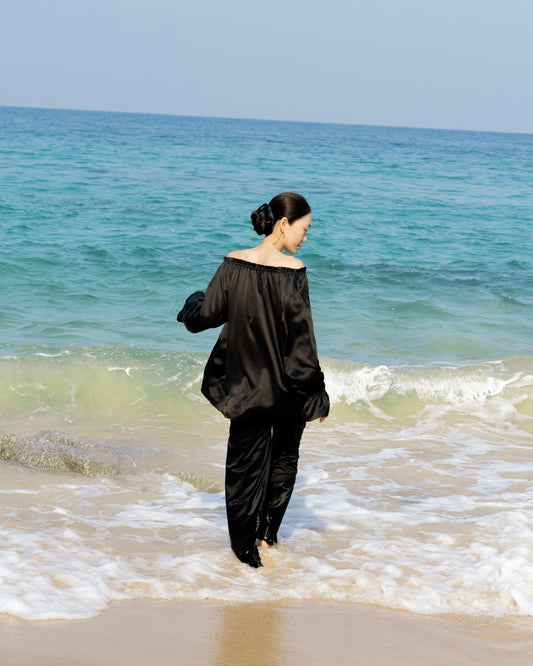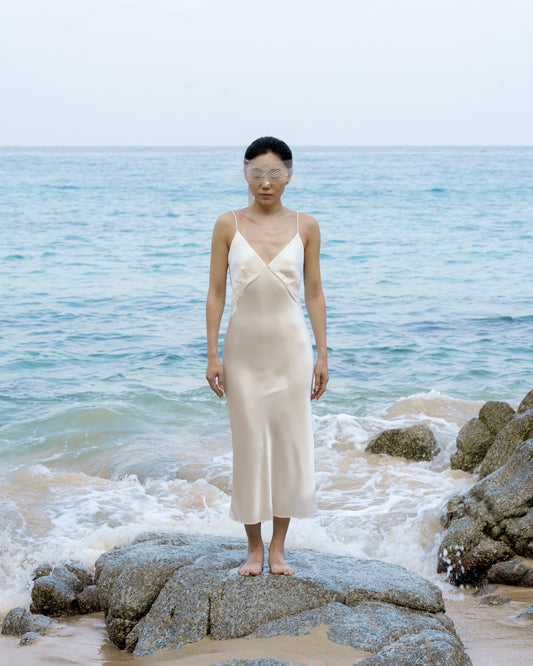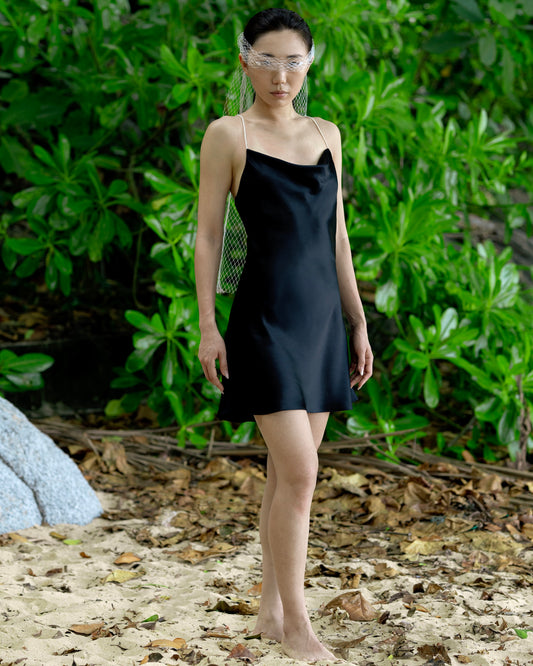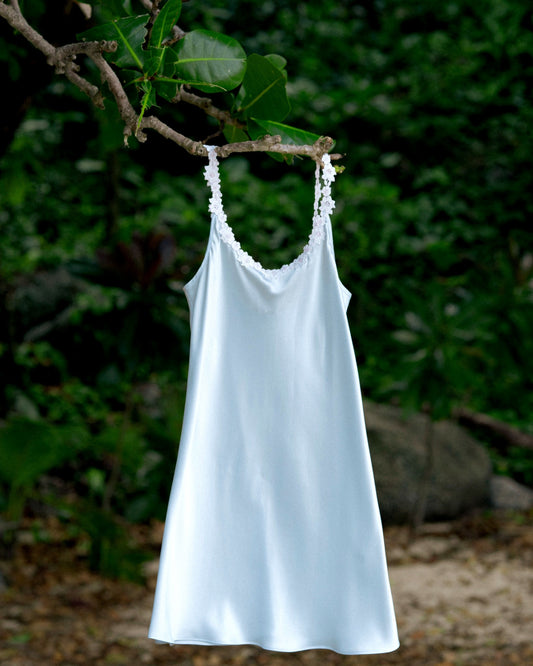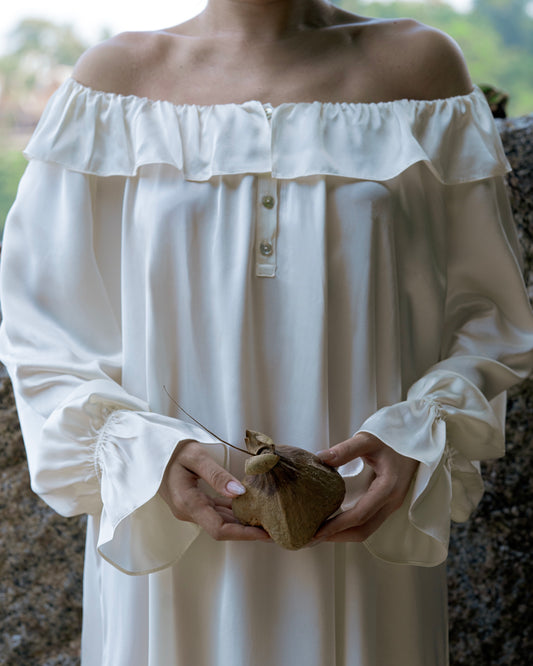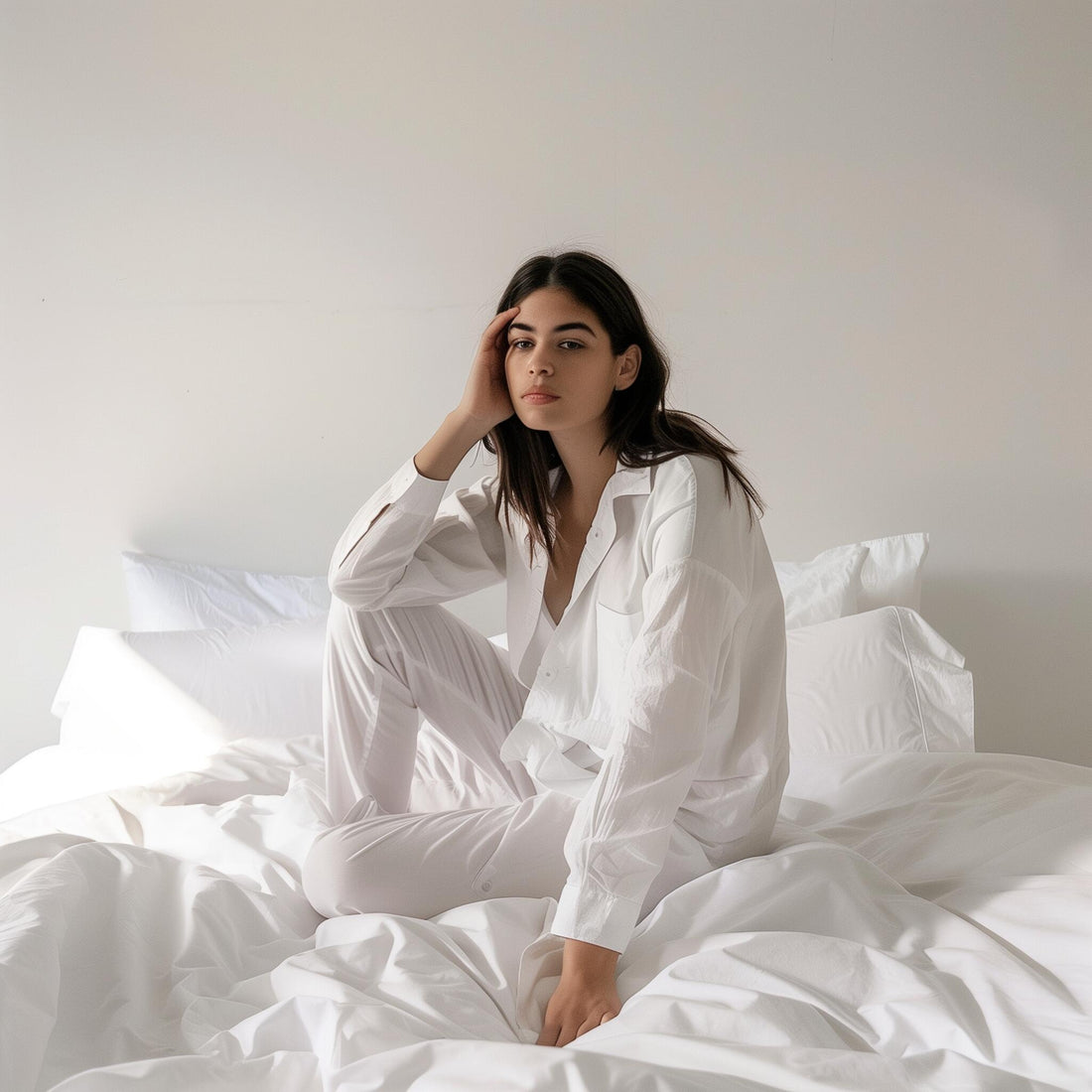
9 Evidence-Backed Silk Pillowcase Benefits
Share
Introduction – The Silk vs. Cotton Debate
Pillowcases might seem trivial, but conscious consumers are buzzing about silk pillowcase benefits. Enthusiasts claim that sleeping on 100% mulberry silk can improve your skin, reduce hair frizz, and even lead to cleaner, more hygienic sleep. Is this just slow-luxury hype, or is there truth behind the trend? We’re taking a clear position: silk pillowcases (and even silk scrunchies) are superior for beauty, hair, and hygiene – and we’ll back this bold claim with facts, studies, and expert insights. Before you dismiss it as marketing fluff, let’s dive into the evidence, address the skeptics’ questions, and see why silk might just earn a spot in your nightly routine.
How Silk Pillowcases Benefit Your Hair (Less Frizz & Breakage)
One of the strongest cases for switching to a silk pillowcase is the impact on hair health. Traditional cotton pillowcases can be rough on your hair. Every toss and turn creates friction between your hair and the fabric, leading to tangles, split ends, and frizz over time. Silk, by contrast, has an ultra-smooth texture that lets hair glide instead of snag. This reduced friction means less hair breakage and bedhead in the morning. In fact, a study in the Journal of Cosmetic Dermatology found that people who slept on silk pillowcases had 35% less hair breakage after eight weeks compared to those using cotton. For anyone trying to grow out damaged hair or preserve a fresh blowout, that’s a compelling statistic.
Moisture retention is another hair-saving advantage of silk. Cotton is highly absorbent – it can soak up 25 times its weight in water, including the natural oils from your strands. Silk absorbs far less moisture, so it helps hair retain its natural oils and any overnight hair products. Well-hydrated hair is more elastic and less prone to snapping or splitting. This is especially beneficial for curly or coily hair, which tends to be drier and more fragile. Experts note that curls don’t hold moisture as well as straight hair, so reducing overnight dryness and friction can preserve curl definition and shine. Even for straight or fine hair, sleepers report smoother, tangle-free locks thanks to silk’s gentle surface.
Silk scrunchies (hair ties wrapped in silk) build on the same principle of gentleness. Dermatologist Dr. Claudia Bernárdez explains that thin elastic hair bands concentrate tension on a small area, often causing hair fibers to fracture. A wider band covered in silk distributes pressure and reduces friction, minimizing damage. In practice, swapping your regular hair tie for a silk scrunchie can prevent that telltale dent in your ponytail and reduce breakage from daily up-dos. It’s a simple change that complements the nighttime benefits of a silk pillowcase. (Pro tip for anti-frizz hair sleep: consider loosely braiding or wrapping hair in a silk bonnet or using a silk scrunchie before bed – it’s an extra layer of protection to wake up with smoother strands.)
Silk Pillowcase Benefits for Skin: Fewer Wrinkles & Clearer Complexion
What about your skin? Beauty gurus often tout silk pillowcases as an anti-aging tool. While no pillowcase is a magic wrinkle eraser, silk does have features that make it more skin-friendly than cotton or linen. The first is friction (again): A coarse pillowcase can tug at your facial skin as you move, creating creases and sleep lines. Over years, those nightly creases can etch into permanent fine lines. Silk offers a far smoother, gentler surface, so your skin glides instead of being pulled. Dermatologists say this reduces morning pillow wrinkles and crease marks. If you’re a side or stomach sleeper who wakes up with sleep lines, a silk pillowcase might help your face “crinkle” less against the pillow. (One clinical study even found that a copper-infused pillowcase led to a measurable reduction in wrinkle depth over time, highlighting how pillow fabrics can affect skin. Silk isn’t infused with copper, but the principle is that a smoother, non-absorbent surface is kinder to your skin.)
Another silk perk for skin is moisture retention. Just as silk doesn’t rob your hair of hydration, it also doesn’t steal moisture from your skin. Cotton pillowcases can absorb your skin’s natural oils and suck up any expensive night creams you apply before bed. Silk, however, is less absorbent, so more of your moisturizer stays on your face where it belongs. By helping your skin stay hydrated overnight, a silk pillowcase can ward off that dry, tight feeling and morning flakiness. In short, it works with your nighttime skincare routine, not against it. As one report put it, silk pillowcases allow skin to retain more moisture, which can prevent dryness and irritation.
Speaking of irritation, silk is famously gentle on sensitive or acne-prone skin. Rough fabrics can exacerbate conditions like eczema or rosacea by causing friction and irritation. Silk’s smooth fibers cause less chafing, which means silk pillowcases may lead to calmer skin if you have inflammatory issues. A study of eczema patients found that wearing silk garments significantly reduced itching and redness, attributed to silk’s soothing properties. You’re probably not going to switch your entire wardrobe to silk, but resting your face on silk each night is a small change that could help soothe acne or sensitive skin. (At the very least, it won’t absorb pore-clogging oils and bacteria as readily as cotton does.)
It’s important to set realistic expectations: a silk pillowcase won’t replace your anti-aging serum or acne treatments. Dermatologists emphasize that factors like UV exposure, diet, and genetics play much bigger roles in skin health. Silk won’t miraculously cure acne or erase deep wrinkles overnight. What it can do is remove some external stressors – less pulling on the skin, less moisture loss, and fewer harsh interactions – creating a better environment for your skin to regenerate at night. Think of silk as one tool in your beauty arsenal: it complements good skincare habits (like gentle cleansing and using sunscreen) by minimizing unnecessary damage while you sleep.
Cleaner & Cooler: The Hygiene and Comfort of Silk
Beyond hair and skin, let’s talk about hygiene and comfort – areas where silk truly shines as a breathable pillowcase material. If you’ve ever woken up sweaty or noticed a musty odor in your bedding, your pillowcase fabric could be partly to blame. Materials like polyester (satin) and even cotton can trap heat and moisture. Silk, on the other hand, is a natural temperature regulator. It feels cool to the touch and helps dissipate excess heat thanks to its fine, breathable fibers. In hot weather, a silk pillowcase wicks away sweat without absorbing it, keeping you cooler and drier. In colder months, silk’s low conductivity can help insulate warmth. This thermal regulation is why silk sheets have been prized for centuries – and it works on pillows too. Hot sleepers often find silk pillowcases prevent that “overnight sweat fest,” leading to a more comfortable, less clammy sleep.
Now consider hygiene: We spend about a third of our lives in bed, and during that time our pillowcase collects sweat, skin cells, oils, and bacteria. A big claim in favor of silk is that it’s naturally hypoallergenic and resistant to common bedroom allergens. There is some truth here: high-quality silk is tightly woven and doesn’t create a hospitable environment for dust mites, mold, or fungus to thrive. Silk fibers also contain a protein called sericin, which studies suggest has antimicrobial properties that might repel certain bacteria and mites. The result is that silk pillowcases tend to stay cleaner longer and may trigger fewer allergic reactions than cotton. Allergy sufferers often notice reduced morning congestion or skin irritation when switching to silk, likely because there’s less buildup of dust and microbes in the pillow fabric.
That said, “hypoallergenic” doesn’t mean “maintenance-free.” Experts point out that any fabric can accumulate allergens over time, silk included. Silk resists mildew and dust mites better than many fabrics, but you still need to wash your pillowcase regularly to keep it truly clean. The good news is silk’s low absorbency helps on this front: because silk doesn’t soak up much moisture or sweat, it’s less of a breeding ground for bacteria and dust mites in the first place. One scientific study found that bacteria tend to flourish more on absorbent materials like cotton, whereas silk’s dryness inhibits bacterial growth. In practical terms, your silk pillowcase might not develop the same funky smell as quickly, and it won’t hold on to oils and dirt as much. Still, regular washing (ideally once a week) is advised for optimal hygiene – silk can absolutely be machine-washed on a gentle, cold cycle.
Finally, silk brings an intangible but important benefit: sheer comfort and “slow luxury”. The phrase “slow luxury” refers to choosing high-quality items that offer lasting value and a mindful experience. A mulberry silk pillowcase exemplifies this – it’s a product of natural fiber and careful craftsmanship (silk is harvested from silkworm cocoons in a time-honored process). The fabric’s smooth, cool feel and lustrous appearance can make your bedtime feel like a pampering ritual rather than just routine sleep. There’s a reason silk is associated with luxury: it elevates the everyday experience of sleep. And when you’re more comfortable, you tend to sleep better – which has its own ripple effect on skin and hair health. In short, silk delivers practical advantages while also turning your pillow into a little slice of indulgence.
Counterarguments & Common Questions (Debunked)
Even with all these benefits, you might still be thinking: “Okay, but is a silk pillowcase really that important?” Healthy skepticism is good! Let’s address some common counterarguments and myths head-on:
“Isn’t this just marketing hype for an expensive pillowcase?”
It’s true that silk pillowcases have been heavily marketed by beauty brands – sometimes with overblown promises. However, the core benefits (less friction and moisture absorption) are backed by science and expert opinion, not just hype. Dermatologists and hair professionals generally agree that silk can help minimize hair breakage and skin creasing, even if they caution it’s not a cure-all. Think of it this way: No one claims a silk pillow will reverse genetic baldness or erase wrinkles overnight. The claim is simply that it reduces certain causes of damage (like mechanical friction and moisture loss) – and that claim stands up to scrutiny. Even skeptical dermatologists say there’s “no harm in trying one” and that there may be a benefit, albeit a modest one, to using silk. In sum, while silk pillowcases won’t replace your dermatologist, they do provide a real, if subtle, boost to your nightly beauty regimen. The key is to view them as one supportive factor among many (alongside good skincare, proper hair care, a healthy diet, etc.), not a miracle product.
“Won’t any smooth pillowcase (like satin) do the same thing?”
Satin is often suggested as a cheaper alternative, and it’s true that a satin-weave polyester pillowcase can mimic some of silk’s feel. It will be smoother than cotton, so it can reduce friction on hair and skin to a degree. However, there are notable differences. Mulberry silk is a natural fiber, whereas polyester satin is synthetic (plastic). Silk’s natural breathability and moisture-wicking far exceed that of polyester. So, while satin stays cool initially, it tends to trap heat and sweat over the night – not so with silk, which remains comfortably cool and dry. Moreover, polyester lacks the hypoallergenic qualities of silk. Silk is naturally resistant to dust mites and mold, but satin can harbor these allergens more readily (since it doesn’t have silk’s protein structure and often isn’t as tightly woven). In short, a satin pillowcase is better than rough cotton, but a 100% mulberry silk pillowcase is the gold standard if you want all the benefits (friction reduction plus cooling breathability, true hypoallergenic potential, and that soft luster). As one textile expert advises, when shopping for a beauty pillowcase, “look for a product made from 100 percent mulberry silk” for the best quality and results. The investment in real silk ensures you’re getting the full package of properties, not just a slick surface.
“Silk pillowcases cost more and need special care – are they worth it?”
It’s true that silk pillowcases cost more upfront than cotton or synthetic ones. You’re paying for a premium natural material and a more labor-intensive production process. However, consider the concept of slow luxury: silk is durable when properly cared for, meaning a quality silk pillowcase can last for years, maintaining its benefits night after night. Many users report that their silk pillowcases, with gentle washing, hold up for 2-3 years before needing replacement. In contrast, a cheap cotton pillowcase might wear out or discolor much sooner (especially if it’s absorbing oils and sweat). As for care, most silk pillowcases today are machine washable on a delicate cycle – you don’t necessarily need to hand wash everything. Use a mild detergent, wash cold, and air dry or tumble low, and your silk pillowcase will thrive. Yes, you might need to treat it a bit more gently (no high-heat dryer or bleach), but it’s not as fussy as some imagine. For many, the benefits to hair, skin, and sleep quality make the extra care worthwhile. And let’s not ignore the luxury aspect: part of the value is how delightful it feels to sleep on silk – if you enjoy that touch of luxury and it helps you sleep soundly, that has its own value. Ultimately, only you can decide if it’s “worth it,” but from a purely functional standpoint, silk pillowcases provide benefits that cheaper fabrics simply can’t match, and they do so over a long lifespan if treated well.
“Will sleeping on silk cure my acne (or wrinkles or hair loss)?”
No, and it’s important to dispel this myth. Some marketing claims have implied that silk’s proteins or amino acids can transfer to your skin and hair to work magic – that’s not how it works. Your skin isn’t absorbing nutrients from the pillowcase. Likewise, if you’re dealing with hormonal acne or genetic hair loss, a pillowcase alone won’t solve it. What silk can do is remove certain irritating factors: it won’t clog pores with absorbed dirt (since it doesn’t hold much dirt to begin with), and it won’t physically abrade or inflame your skin the way a rough fabric might. This can reduce some triggers of acne or irritation, potentially leading to fewer breakouts or less redness over time. But silk is not a replacement for proper skin treatment or medical care. Dermatologists view silk pillowcases as a complementary lifestyle change – “not a panacea... but something nice to add to your toolbox,” as one expert put it. The same goes for wrinkles: silk can help prevent sleep lines, but it won’t erase sun damage or stop the natural aging process. And for hair loss: if you’re experiencing alopecia or shedding due to health reasons, silk won’t stop that (it prevents breakage, which is different from hair falling out at the root). To summarize, keep your expectations realistic. Enjoy silk for the subtle improvements and comfort it provides, not as a miracle cure for dermatological issues. And if anyone selling silk products claims overnight transformations, take it with a grain of salt.
“I care about sustainability – is silk a conscious choice?”
Silk is an animal-derived fiber (from silkworms), so it’s not vegan, and traditional sericulture does involve killing the silkworms during harvest. For eco-conscious or cruelty-conscious consumers, this is a valid concern. The silk industry today does offer options like Ahimsa silk (peace silk), where the moths are allowed to emerge from cocoons, though this process is costlier and yields shorter fibers. There are also efforts to produce organic mulberry silk, meaning the silkworms are raised on organic mulberry leaves and the processing of silk involves fewer chemicals. On the plus side, silk is a natural, biodegradable fabric – unlike polyester satin (which is synthetic and sheds microplastics), silk will decompose and doesn’t contribute to plastic pollution. It’s also long-lasting (as discussed) and thus doesn’t need frequent replacing. “Slow luxury” is inherently about buying less and buying better. By that ethos, investing in one silk pillowcase that you use for years can be seen as a conscious choice versus cycling through many cheaper, short-lived products. If ethical sourcing matters to you, look for brands that offer certified organic silk or peace silk. These indicate a more environmentally friendly production and, in the case of peace silk, a more humane approach to the silkworms. While silk will never be as low-impact as, say, organic cotton in terms of not involving animals, its longevity and natural origins earn it a place in the conversation about sustainable luxury. Ultimately, choosing silk aligns with a mindset of valuing quality, natural materials, and care for one’s belongings – a refreshing shift from the throwaway culture.
Conclusion: The Case for Silk – Luxury Meets Logic
From nature to luxury – these are mulberry silkworm cocoons, the source of genuine mulberry silk. It’s a slow, natural process to produce silk, which is why silk is often called a “slow luxury” fabric. In the end, that patience yields a pillowcase material that marries luxury with real benefits for your nightly routine.
After weighing the evidence, the verdict is clear: silk pillowcases truly offer a tangible upgrade for your beauty sleep. They minimize hair damage, help your skin stay hydrated with fewer creases, and maintain a cleaner, cooler sleeping environment. We’ve presented the facts, from studies showing reduced hair breakage on silk to expert testimonies on silk’s benefits for curly hair and sensitive skin. We’ve also tackled the counterarguments – acknowledging that silk isn’t a miracle cure, but demonstrating that its advantages are far from myth. This balanced view is exactly what a conscious consumer like you deserves: the truth, un-hyped but optimistic.
In the end, embracing a 100% mulberry silk pillowcase (and maybe a silk scrunchie) comes down to a blend of luxury and logic. Yes, it feels indulgent – and there’s value in that feeling of sleeping on something sumptuous. But it’s also a rational choice backed by dermatological sense: smoother, less absorbent fabric = less wear and tear on you. This is the ethos of slow luxury: a high-quality item that improves daily life in subtle but meaningful ways. By investing in silk, you invest in better mornings – waking up with hair that’s easier to manage and skin that looks like it actually slept well. You invest in a bit of self-care that pays dividends over time (in both comfort and possibly fewer beauty products to counteract dryness or breakage). And because mulberry silk is durable, that investment isn’t fleeting.
As you lay your head down tonight, consider what’s underneath it. You now have the facts to make an informed decision. For many, the choice has been a game-changer: trading cotton for silk to reduce wrinkles while sleeping and to pamper their hair. For others, it’s simply about elevating a nightly ritual – because we all deserve to feel good as we drift off to dreamland. Wherever you fall, one thing is certain: silk pillowcases have moved from a niche trend to a well-grounded recommendation in the realm of skin and hair care. Sometimes, the fancy solution also turns out to be the smart solution. And that is the silky truth.
Sweet dreams!
— Liu&Liu
FAQ
- Do silk pillowcases reduce frizz?
- Is silk better than satin for acne-prone skin?
- How often should I wash a silk pillowcase?
- What’s the best momme for pillowcases (19 vs 22)?
- Is mulberry silk worth it vs polyester satin?
Sources:
- SleepFoundation.org – Benefits of a Silk Pillowcase(sleepfoundation.orgsleepfoundation.orgsleepfoundation.org)
- Washington Post – Silk pillowcases for better hair and skin: What to know(washingtonpost.comwashingtonpost.comwashingtonpost.com)
- Journal of Cosmetic Dermatology – Study on silk vs cotton pillowcases (2021)(asilklife.com)
- MattressNerd – 5 Benefits of a Silk Pillowcase(mattressnerd.commattressnerd.commattressnerd.commattressnerd.com)
- Vogue – Dermatologist’s trick to stop hair breakage (silk scrunchies)(vogue.comvogue.com)
- Clementine Sleepwear Journal – Guide to Hypoallergenic Pillowcases(sleepwithclementine.comsleepwithclementine.com)
- Asilklife Blog – Silk vs Satin differences(asilklife.com) and expert commentary(asilklife.com)

